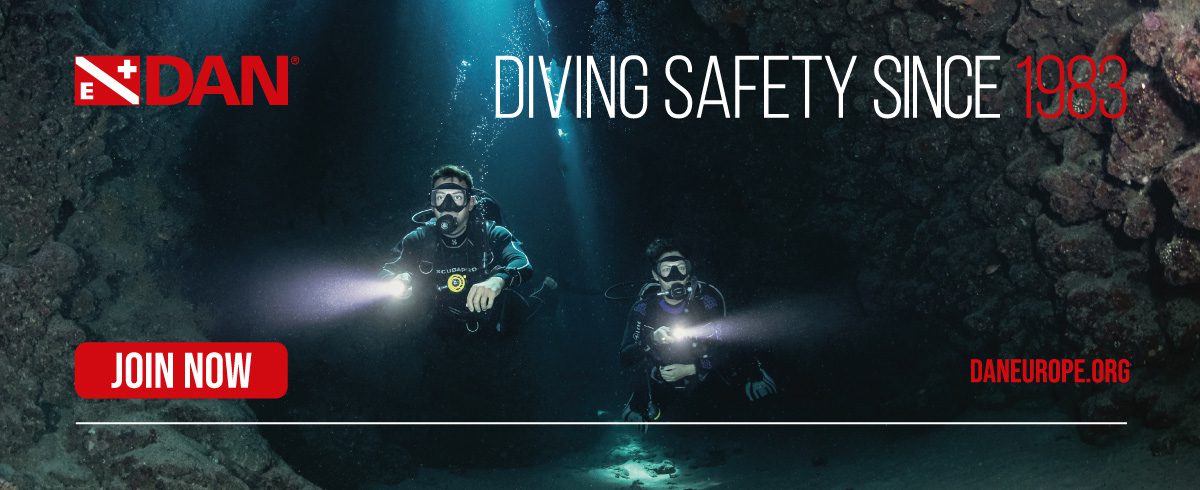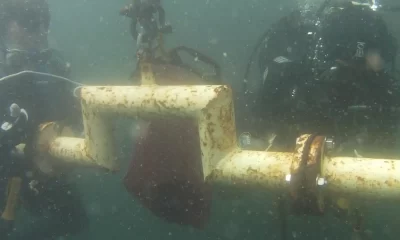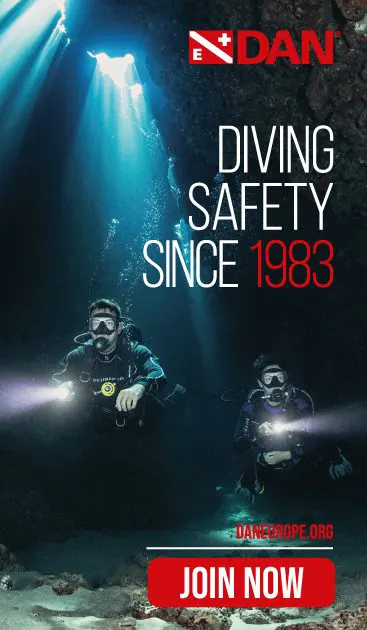Education
Anatomy of a Fundamentals Class
GUE Instructor Examiner Guy Shockey explains the thought and details that goes into GUE’s most popular course, Fundamentals, aka “Fundies,” which has been taken by numerous industry luminaries. Why all the fanfare? Shockey characterizes the magic as “simple things done precisely!”

By Guy Shockey
Header image by Julian Mühlenhaus.
Divers are attracted to GUE training for a variety of reasons, some of which may include a desire to increase their level of comfort and safety in the water and continue their diving education with world class instructors. Some divers might be experiencing dissatisfaction with their previous training, or they might simply want to begin their training in technical or cave diving. The reasons are as varied as the individuals. For most divers who are already open-water certified, the first step in the GUE training ladder is the GUE Fundamentals course. So, let’s talk about what a Fundamentals course is, what you should expect, and what actually happens in the class.
Fundamentals is a four-day course that includes a minimum of 30 hours of instruction. The course consists of both academic class work, out-of-water drills, and instruction in the water. You will most likely also participate in a pool session as well, where you will be expected to complete your swim test and your breath-hold swim test.

During your classroom work, you will cover several subjects including but not limited to buoyancy and trim, streamlining and equipment configuration, propulsion techniques, situational awareness, communication, breathing gas overview and dive planning, and gas management. Many of these subjects will be familiar to you from previous diving courses, but in the case of Fundamentals course, you should expect a superior standard of instruction compared to what you have received previously. Note also that the diving portion of the class is conducted using nitrox 32, GUE’s basic standard breathing gas. If you are not already certified to dive nitrox, you will also come away with a nitrox certification.

One of the central tenants of GUE instruction is the importance of the team in diving. Consequently, your course will begin with an introduction of all your teammates as well as your GUE instructor. GUE instructors are experienced divers and educators and truly enjoy sharing their experiences with their students. In many cases, you may not be familiar with your course mates, and this introduction serves to begin the team-building process. Your instructor will also take this opportunity to spend some time introducing GUE as an agency.
Simple Things Done Precisely
It has been said that the GUE Fundamentals instruction can be best summarized as “simple things done precisely.” While nothing about Fundamentals is complicated, you will still be expected to achieve a particular objective standard of performance before you earn a passing grade in this class.
This objective performance standard is spelled out clearly in GUE Standards. Even though your instructor will go over this with you very thoroughly at the beginning of your class, you should review it for yourself on the GUE website. For the majority of divers, this will be the first time in their diving education that they will have been exposed to an objective performance standard. There is no subjectivity here: you either meet the performance standard or you don’t.
On this basis, your instructor will then decide if you have met the performance standard criteria for:
a) Receiving a Technical pass, the standards of which are quite high, and which is necessary for you to continue your GUE training in either technical or cave diving
b) Achieving a Recreational pass for those who plan to continue rec diving
c) Receiving a Provisional pass, requiring that you practice and return later for re-evaluation
d) Failing the class

As was mentioned, the performance criteria are not complicated in and of themselves. For example, maintaining neutral buoyancy throughout the water column is not a difficult task, but you will be expected to maintain a “buoyancy window” that is either 1 m/3 ft or 1.5 m/5 ft depending on whether you are looking for a “Tech” pass or a “Rec” pass.
You will be expected to demonstrate advanced propulsion techniques such as the frog kick, the modified frog kick, the flutter kick, the modified flutter kick, and the back kick. Again, these propulsion techniques are not difficult, but they will require some practice. You will also be expected to maintain a certain standard of “trim” in the water. Trim refers to your ability to demonstrate a horizontal attitude in the water. You will also need to demonstrate a series of drills in the water while maintaining buoyancy and trim. This sounds simple, but it is probably the most difficult part of the course since a little task loading can complicate an otherwise reasonable demonstration of buoyancy and trim.
Creating Thinking Divers
GUE students are expected to come to GUE classes with the required equipment as specified in the course outline. During the first part of your class, your instructor will go over all your diving gear thoroughly, will provide a critical review of your equipment, and will offer suggestions on its appropriateness and fit.
That’s when you can start asking questions: GUE divers are thinking divers and do not adopt a particular piece of equipment or gear configuration for a less-than-optimal reason. If you want to know the “why” of something, ask. There are no “because” answers in GUE: each question has probably been addressed somewhere by someone, and if your instructor does not have a logical and concise answer, they will find it for you.
The rest of your course will consist of both classroom lectures as well as open-water diving, where you will practice and demonstrate your skills. These water sessions will be somewhat different than what you may have experienced in your previous diving training. This is not a case of “follow-me” diving but hands-on education where you are expected to organize, lead, and run your own dives.
Getting Wet
A team captain will be appointed for each dive, and they will be expected to lead the divers in the water as much as a sports team captain marshals the players on the field. This role will be rotated throughout the team, and everyone will get multiple opportunities to lead dives. Your instructor will evaluate your progress and provide you with meaningful feedback and concrete suggestions.
This feedback will also be supplemented by your instructor’s secret weapon: video review. Each dive session will be recorded on video to assist in the debriefing. The power of a video replay is extremely effective! You will be able to see, in glorious HD, how you are progressing. It takes the subjectivity completely out of the equation and provides useful information for your instructor to assist in helping you to correct mistakes as well as allowing you to reinforce existing good skills.
As mentioned, you will be expected to complete your swim test and your breath-hold swim test. Ironically the swim test seems to be one of the most dreaded parts of the course, yet it is also the part of the course which you can easily prepare for and practice beforehand!
Consider that, as a diver, you are in open water, and the only thing keeping you from drowning is your life support equipment or your ability to float or swim. It only stands to reason that you would be able to demonstrate a moderate ability to swim! If you feel this may be a problem, I would strongly suggest taking a few lessons beforehand and work on your swim technique.
You should expect to spend a lot of time in the water and need to make sure your exposure protection is sufficient. Make no mistake: this course is intense and comes fast and furious. Your instructor will allow as much time as possible for you to practice or repeat your skills during the course, but the course does have an expiration date. That said, there are several things you can do to make the most of your time in the water.
Be Prepared
To recap, it’s important to come to class prepared by having done all the required reading and pre-class exercises. You and your teammates are investing a good deal of time and money in this training, and it is not fair to expect the rest of the class to receive less value for their training because you did not do the preparatory work. Also, keep in mind that the course is intense and often goes into the evening. You will be tired and perhaps want to skip the required reading. Don’t make that mistake. None of your previous training will make up for not being prepared.
Next, if you are unsure about the equipment requirements, contact your instructor for advice. These requirements are very specific and are there for your benefit. You will understand why once you start the course. If you are fortunate to have the opportunity to dive or socialize with GUE trained divers, ask them about their gear arrangement. Moreover, if you decide to take the class in double cylinders, get some experience with them beforehand. A Fundamentals class is not the place to experiment for the first time with a new drysuit or a new set of doubles. Don’t add to your task loading by having to manage new equipment.

Finally, and perhaps most importantly, find some GUE divers in your area and dive with them. They can be a useful resource regarding your upcoming course. Mentorship is a very important part of GUE diving, and I don’t know a single GUE diver who wouldn’t be willing to help a newbie with advice, and most likely be inclined to jump in the water to help with skill development.
GUE Fundamentals is all about simple things done precisely. Students consistently come away from the class feeling that they received good value for their dollar. Remember, when beginning a journey, the knowledge of where you want to go is essential. Also necessary is an understanding of where you are when you begin your journey. At the completion of the GUE Fundamentals course, you will have a very clear picture of where you are in terms of your diving. The nature of the course provides everyone with an objective, standardized frame of reference.
You will also have a very clear picture of where you are in relation to the baseline for diving competency. Remember that it doesn’t matter where you are in this learning curve so much as it matters that you know where you are. Many problems and incidents in diving come from unprepared divers encountering unexpected circumstances. The real value of the Fundamentals class is that it will show you exactly where you are on that learning curve, and it will substantially move you along it in just four days!
Dive Deeper:
InDepth: Back to Fundamentals: An Introduction to GUE’s Most Popular Diving Course by Rich Walker
InDepth: Never Too Late: Veteran Sports Diver Tackles GUE Fundamentals by Sue Crowe
GUE: GUE Diver Training

Guy Shockey is a GUE instructor and trainer who is actively involved in mentoring the next generation of GUE divers. He started diving in 1982 in a cold mountain lake in Alberta, Canada. Since then he has logged somewhere close to 8,000 dives in most of the oceans of the world. He is a passionate technical diver with a particular interest in deeper ocean wreck diving. He is a former military officer and professional hunter with both bachelor’s and master’s degrees in political science. He is also an entrepreneur with several successful startup companies to his credit.



















































